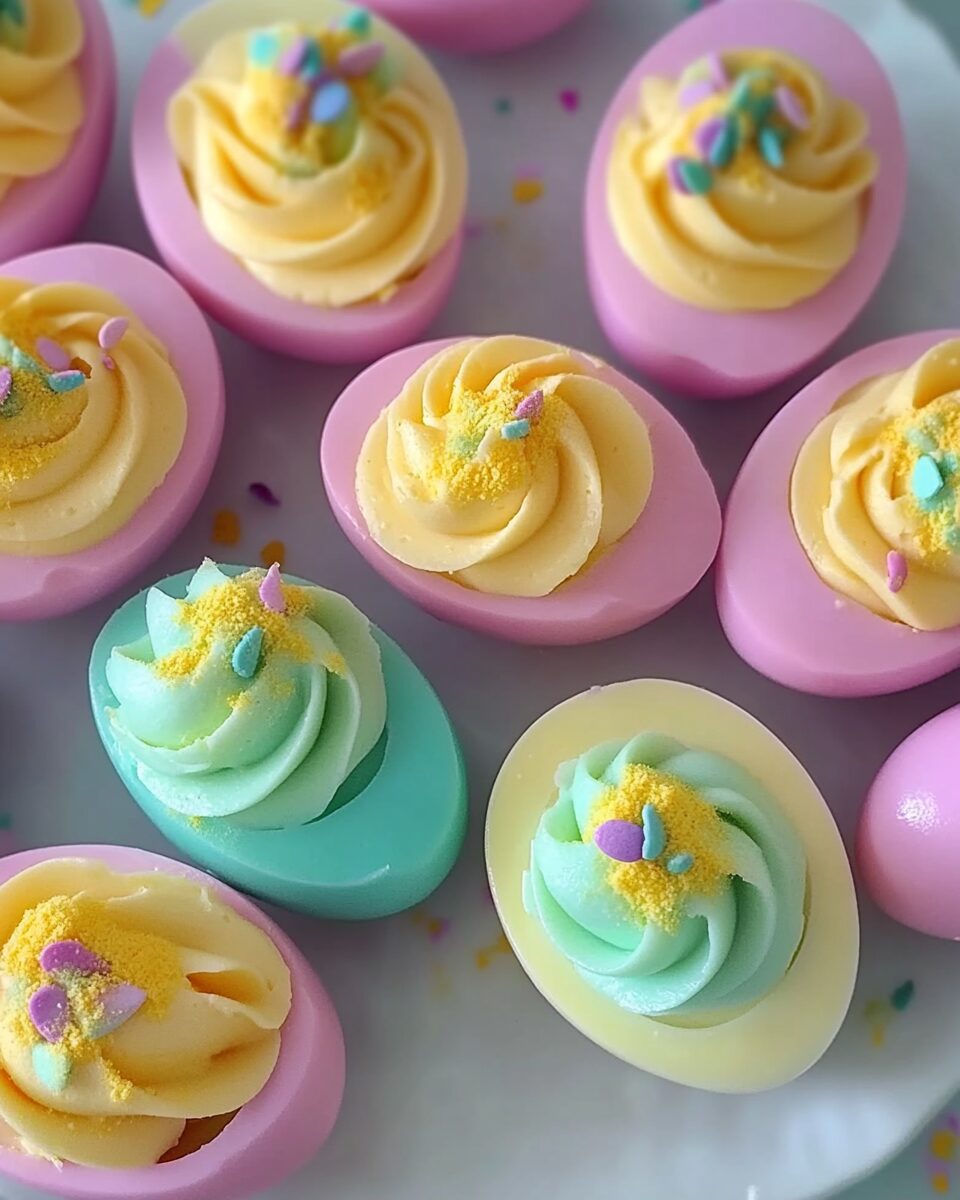Easter Deviled Eggs are a festive twist on the classic appetizer, adding vibrant colors to brighten your holiday table. By incorporating food coloring into the preparation, these deviled eggs become not only a delicious treat but also a visually appealing addition to your Easter celebration.
Full recipe:
Ingredients
- 12 large eggs
- ¼ cup creamy salad dressing (such as Miracle Whip)
- ¼ teaspoon dry mustard
- Salt and ground black pepper to taste
- Hot sauce (optional)
- Red, blue, and green food coloring
- 3 cups water, divided, or as needed
Directions
- Place eggs into a large saucepan; cover with cold water and bring to a boil. Let eggs boil for 3 minutes; turn off heat, cover pot, and let eggs cook in hot water for at least 20 minutes. Drain and cover eggs with cold water. Peel cooled eggs.
- Cut hard-cooked eggs in half lengthwise and remove yolks; mash yolks in a bowl with creamy salad dressing, dry mustard, salt, pepper, and hot sauce until smooth.
- Place red, blue, and green food coloring into 3 different bowls and add about 1 cup water to each bowl. Steep 8 egg white halves in each bowl, tinting the egg whites pink, light blue, and green. If color is too pale, add more food coloring to bowls. Drain colored egg whites on paper towels.
- Pipe or spoon egg yolk filling into colored egg white halves; cover and chill before serving, at least 30 minutes.
Nutritional Facts
Per serving (2 halves):
- Calories: 130
- Total Fat: 9g
- Saturated Fat: 2.5g
- Cholesterol: 285mg
- Sodium: 210mg
- Total Carbohydrates: 1g
- Dietary Fiber: 0g
- Sugars: 1g
- Protein: 11g
The History of Deviled Eggs
Deviled eggs have a long and fascinating history that dates back to ancient times. The concept of stuffing eggs can be traced to ancient Rome, where hard-boiled eggs were filled with herbs, cheese, and spices and served as a luxurious appetizer. This idea later spread across Europe, with variations emerging in Spain, France, and England.
The term “deviled” originated in the 18th century, referring to foods that were heavily spiced or seasoned. By the 19th century, deviled eggs became a popular dish in America, often featuring mustard, mayonnaise, and paprika. Today, deviled eggs are a staple at picnics, potlucks, and holiday gatherings, and they continue to be reinvented with creative flavors and presentations.
Why Easter Deviled Eggs Are Special
Easter Deviled Eggs are more than just a delicious appetizer—they are a festive way to celebrate the season. Here’s what makes them stand out:
- Vibrant and Eye-Catching Presentation: The pastel-colored egg whites make these deviled eggs perfect for Easter and spring gatherings.
- Simple Yet Elegant: Despite their fun appearance, these eggs maintain the classic elegance of traditional deviled eggs.
- Kid-Friendly and Fun to Make: The coloring process makes this a great recipe to prepare with children, allowing them to take part in the Easter festivities.
- Customizable Fillings: While the standard filling is creamy and tangy, variations can be made to suit different tastes and dietary needs.
Health Benefits of Deviled Eggs
Eggs are one of nature’s most nutrient-dense foods, making deviled eggs a healthy addition to any meal when consumed in moderation. Here are some of the key health benefits:
- Rich in Protein: Eggs are an excellent source of high-quality protein, which is essential for muscle growth, repair, and overall body function.
- Packed with Vitamins and Minerals: Eggs contain essential vitamins such as vitamin D, B12, and choline, which support brain health, metabolism, and immune function.
- Good for Eye Health: The lutein and zeaxanthin in eggs help protect against age-related macular degeneration and support overall vision health.
- Low in Carbohydrates: Deviled eggs are a low-carb snack, making them a great option for those following keto or low-carb diets.
- Heart-Healthy Fats: While eggs contain cholesterol, research shows that dietary cholesterol does not necessarily raise blood cholesterol levels for most people. The healthy fats in eggs can support cardiovascular health when consumed as part of a balanced diet.
Creative Variations of Easter Deviled Eggs
One of the best things about deviled eggs is their versatility. Here are some fun variations to try:
- Spicy Easter Deviled Eggs: Add a touch of hot sauce, cayenne pepper, or jalapeño to the filling for a spicy kick.
- Avocado Deviled Eggs: Replace the mayonnaise with mashed avocado for a creamy, nutrient-rich alternative.
- Bacon and Cheddar Deviled Eggs: Mix in crumbled bacon and shredded cheddar cheese for a savory, smoky twist.
- Herb and Garlic Deviled Eggs: Enhance the flavor with fresh herbs like dill, parsley, or chives, and a hint of garlic.
- Smoked Salmon Deviled Eggs: Add flaked smoked salmon and capers for a luxurious, seafood-inspired version.
How to Serve Easter Deviled Eggs
Easter Deviled Eggs are best enjoyed as a party appetizer or side dish. Here are some serving suggestions:
- Easter Brunch: Pair them with quiches, croissants, and fresh fruit for a festive brunch spread.
- Spring Picnic: Serve them alongside sandwiches, salads, and lemonade for a refreshing outdoor meal.
- Holiday Gatherings: Arrange them on a decorative platter and garnish with fresh herbs, paprika, or edible flowers for an elegant presentation.
- Buffet Table Favorite: Place them on a tiered serving dish with other appetizers like cheese, crackers, and dips.
Tips for Making the Perfect Easter Deviled Eggs
To ensure your deviled eggs turn out perfectly every time, follow these helpful tips:
- Use Fresh Eggs: Fresh eggs result in the best texture and flavor, but slightly older eggs are easier to peel after boiling.
- Perfect the Boiling Process: Avoid overcooking the eggs to prevent a greenish-gray ring around the yolk. A gentle boil and cooling process help maintain a bright yellow yolk.
- Mash the Filling Until Smooth: Use a fork or food processor to ensure the filling is creamy and lump-free.
- Don’t Overdo the Coloring: The eggs should be pastel, not overly saturated. A quick dip in food coloring is enough to achieve the desired look.
- Use a Piping Bag for Presentation: A piping bag with a decorative tip makes filling the eggs look more professional and appealing.
How to Store and Keep Easter Deviled Eggs Fresh
Deviled eggs are best served fresh but can be stored for later enjoyment. Here’s how to keep them fresh:
- Refrigerate Immediately: Deviled eggs should be stored in the refrigerator within two hours of preparation.
- Use an Airtight Container: Keep them in a single layer in an airtight container to prevent them from absorbing other fridge odors.
- Consume Within Two Days: While they can last up to four days, they taste best within the first two days.
- Avoid Freezing: Deviled eggs do not freeze well as the filling and egg whites become watery after thawing.
Conclusion
Easter Deviled Eggs are a delightful way to add color and flavor to your holiday celebrations. Their festive appearance, combined with the classic deviled egg taste, makes them a favorite at Easter gatherings, spring brunches, and family picnics. Not only are they easy to prepare, but they also offer a nutritious, protein-packed snack that appeals to all ages. With endless variations and customization options, you can get creative with flavors while still maintaining the traditional creamy and tangy filling. Whether you prefer a classic version or a unique twist, Easter Deviled Eggs are sure to be a hit at your next celebration.






